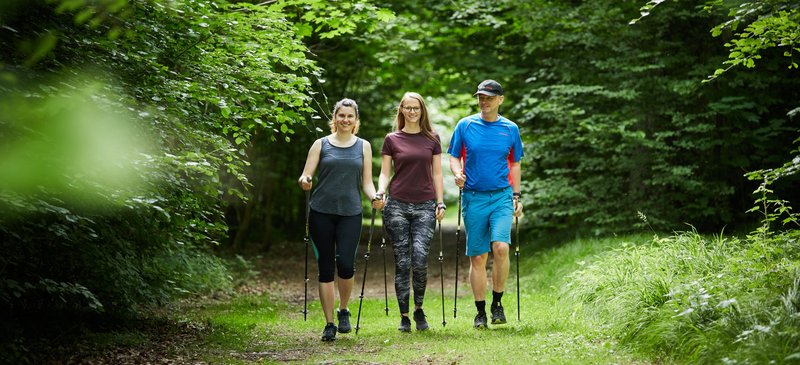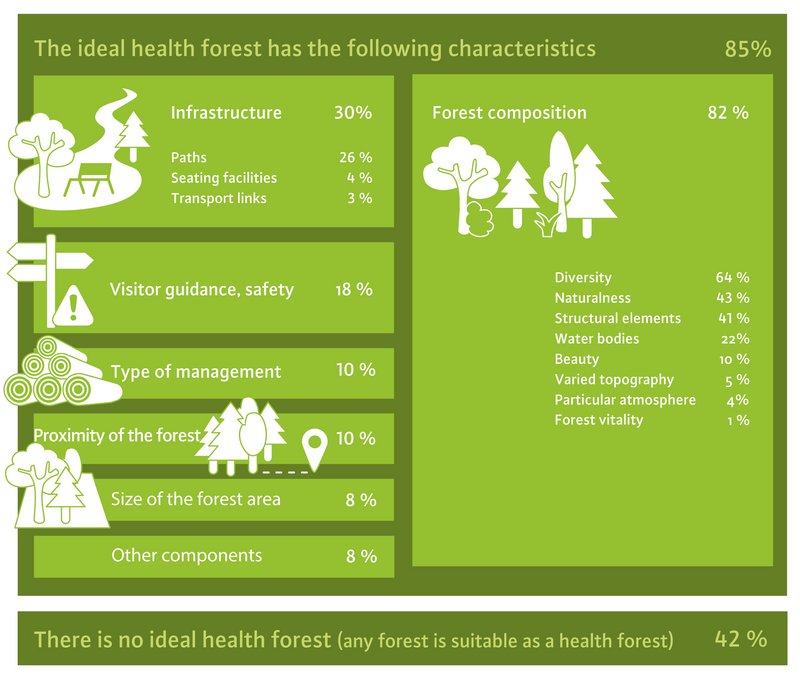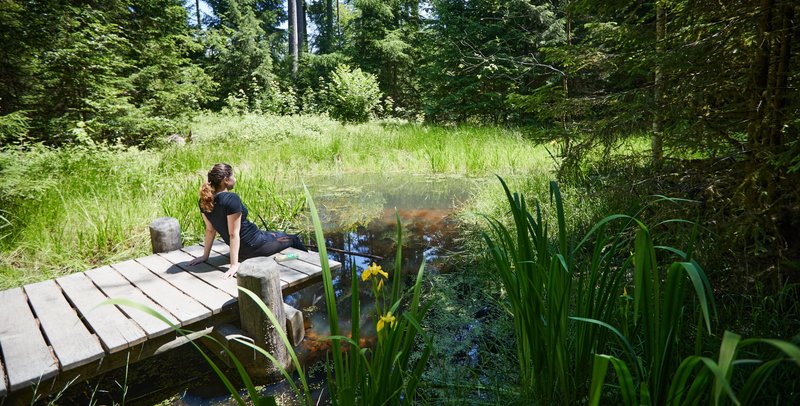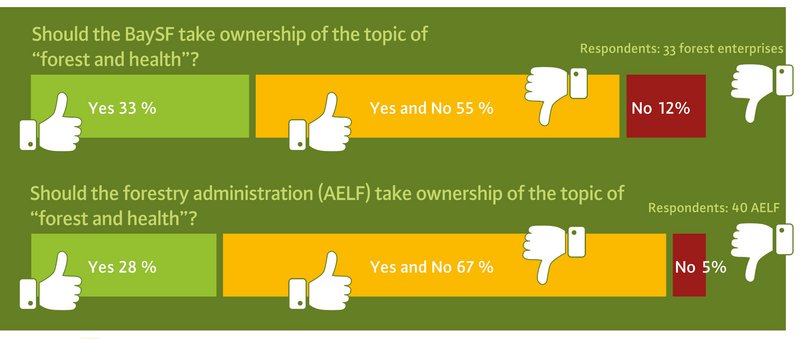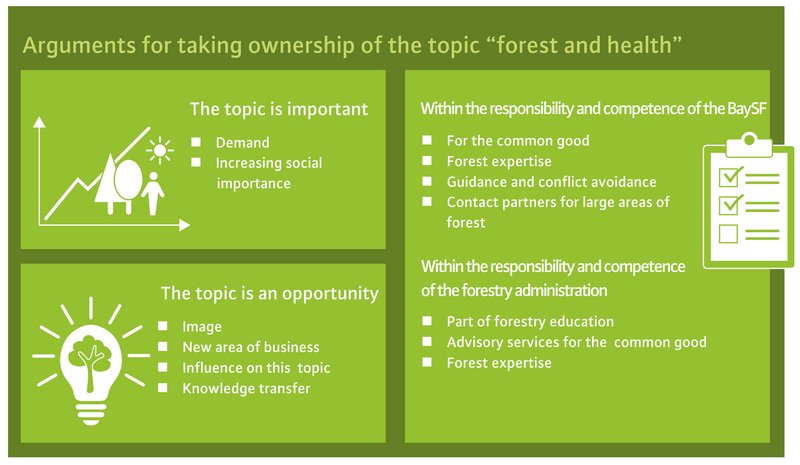The INTERREG project “Health Network Forest” focused on the sustainable use of forests and natural areas for health tourism. The project gives interested parties and forest owners an insight into ways of developing business models for this form of forest utilisation at local level.
It covers the following issues: What service providers and services are there in the field of preventative healthcare and therapy in Bavarian forests? Which forests are suitable for such offers from the perspective of healthcare providers? And how do forest stakeholders such as the Bavarian State Forest Company (BaySF) or the Bavarian Forestry Administration assess the topic of “forest and health”?
Who uses the forest for health purposes?
The range of “forest and health” offers available is growing and becoming increasingly diverse. Clinics use forest areas in their surroundings for therapeutic programmes, for example, in cooperation with forest owners. Official structures like this that are relevant for our project also include spa and healing forests. These are forested areas of between 2 and several hundred hectares that are explicitly dedicated to health uses. There are currently various certification systems in Germany recognising designated spa and healing forests.
Spa forests primarily serve human health promotion and disease prevention. The healing forest is a medical treatment facility in the great outdoors which is suitable for the therapeutic treatment of disease and for rehabilitation, as well as disease prevention. Healing forests in particular may require higher standards of infrastructure, such as barrier-free paths. The first spa and healing forests have now also been established in Bavaria.
In addition to these official structures relevant to the project, independent consultants from various professions have also established themselves here, offering preventative healthcare programmes in the forest in a broader sense. They include therapists, nature coaches, forest bathing providers, mindfulness coaches, sports and fitness coaches, but also forest education and nature experience specialists. They market their services through tourist offices, adult education centres, and occasionally also via forest experience facilities or their own websites. Their courses and consultancies take place not only in forest areas specially designated for health use (e.g. in spa or healing forests), but in forests all over Bavaria.
The ideal health forest
To find out what health service providers expect from forests, 74 forest bathing providers, non-medical psychotherapists and nature coaches were interviewed by telephone. Among other things, they were asked to describe the elements that make up an ideal health forest (Figure 2). It is worth noting that 42 % of the respondents stated that they did not believe there was an ideal health forest, but that any forest was suitable for health purposes. 85 % of those surveyed did however name certain characteristics that such a forest should have. These include a certain forest composition, existing infrastructure (e.g. a system of trails in good condition), or elements to guide visitors or ensure their safety (e.g. signs).
The composition of the forest (82 %) is most frequently defined by its diversity, individual structural elements and its naturalness. The respondents described diversity in terms of a tiered, mixed forest, characterised by different tree species, height and age structures, as well as a varied play of light and shade. In addition to variety, they would like to see individual structural elements such as old and particularly beautiful individual trees, clearings, or viewing points. A “natural” forest appearance is also favoured, as long as it does not overwhelm the visitor (not too wild, not too much deadwood, not too chaotic an overall impression). Water bodies such as streams or ponds are elements that enrich the forest and, from the perspective of health service providers, create opportunities for them to integrate water elements in therapies such as mindfulness exercises, for example (Figure 3).
The forest people use is the forest nearby
If you ask healthcare providers what kind of forests they use for their services, the most common response is “I go to the forest on my doorstep”. The respondents have a very pragmatic approach, choosing to avoid long journeys, for example, or because they know the forests in their neighbourhood well. Even if some of the forests used do not always fulfil the ideal requirements, the decisive criterion when selecting a forest is that it is available at all. If it is also perceived as being varied, it usually meets the respondents’ requirements. Prevention and health promotion services are therefore not limited to a small number of forest areas that are particularly suitable for health-related use (e.g. spa and medicinal forests). In fact they are widely distributed and offered close to settlements and transport links (e.g. car parks for hikers).
A health forest is a recreational forest
The expectations that health service providers have of an ideal health forest largely coincide with people’s requirements for a recreational forest. The comprehensive experience of the natural forest environment using all of the senses (smells, tranquillity, sounds of the forest, greenery, viewing points), the absence of civilisation (noise, everyday life, traffic), and diversity and change are classic and important elements of recreation. These are also used by players in the healthcare sector to promote the health of their clients. Forest owners and foresters can therefore use the criteria for recreational forests as a guide when selecting potential forest areas (see LWF leaflet 39 Recreation in the forest - a challenge and an opportunity) [Available in German only].
A further aspect that should be taken into account is the special requirements for the accessibility of the stands. Unlike traditional recreational activities (e.g. walking), where forest visitors generally stay on the forest paths, the therapeutic activities offered by health service providers often take place on forest areas off the paths. Although vegetation such as grasses or shrubs is desirable, it must not obstruct access to large areas of the forest. Potential sources of danger such as deadwood must also be taken into account when selecting forest areas.
Contact with forest owners
If healthcare providers are commercially active in the forest, they require the consent of the forest owner. There are differences between the survey groups with regard to their sensitivity towards dealing with forest property: More than half of the respondents (57%) state that they exchange information with those responsible for the forest areas; 24% have some contact; and 19% have no contact. 88% of forest bathing providers coordinate their activities with foresters and private forest owners, etc., compared to only 26% and 35% of alternative practitioners and nature coaches in the sample - forest bathing providers are therefore more likely to contact forest owners and institutions such as the forestry administration or local authorities. This is probably due to the fact that most of the forest bathing providers who took part in the survey have undergone further education or training. The issues of forest ownership, access rights and forest management are generally an integral part of the various training programmes. In some cases, instructors with a background in forestry are involved.
Limits of the right of free access: The right of access is enshrined in the Federal Forest Act and in Article 141 of the Bavarian Constitution. This means that anyone is permitted to enter the forest, even off the beaten track, to enjoy the natural beauty of the forest and for recreational purposes. Visitors enter the forest at their own risk, and their presence must be countenanced by the forest owner. Groups are also entitled to enter the forest. A running group or forest bathing session with an instructor thus fall under the general right of access, provided that the recreational purpose is the main focus. It is different for programmes or events where the organiser is representing commercial or industrial interests. In this case the consent of the landowner is required.
Forest and health: An opportunity for the forestry industry
In addition to recording the points of view of healthcare providers, the project also assessed the views of forestry stakeholders on the topic of forests and health. For this purpose, a written survey was carried out among employees of the forestry offices (Offices for Food, Agriculture and Forestry/ÄELF) and the forest enterprises of the Bavarian State Forestry Enterprise BaySF. A total of 40 ÄELF forestry offices and 33 BaySF forest enterprises took part in the survey.
Respondents from both the AELF forestry offices and BaySF state forestry company predominantly see the topic of forests and health as an opportunity (see Figure 5). Only 12% of the forestry enterprises and 5% of the forestry offices reject an active approach to the topic of forest and health as a matter of principle. Another 55% and 67% of respondents respectively found arguments both in favour and against.
When asked about the arguments against dealing with this topic, the main factors cited are a lack of personnel, as well as funding and time limitations. Due to staff shortages and the importance of tasks such as forest restructuring, there is not enough time to deal with other, less urgent issues. In addition, there is some uncertainty in the AELF offices and BaySF enterprises as to whether health issues in the forest even fall within their area of expertise. From the point of view of the respondents, there is a lack of clear instruction on this topic from the higher levels of their organisation. It is thus down to the attitudes of individual division managers, forest operations managers and local foresters whether the topic of forest and health is addressed or not. A clearer positioning of the forest administration and BaySF forest enterprises on the topic of forest and health could eliminate ambiguities relating to the relevant tasks and responsibilities. It would also enable resources to be made available specifically for this area.
Despite the arguments against it, most respondents from the BaySF forest enterprises and the forestry administration think it makes sense for them to take up this topic and to take ownership of it as institutions (Figure 6). On the one hand, “forest and health” presents an opportunity for public relations work in forestry. Forest owners, the BaySF forest enterprises and the Bavarian Forestry Administration take care of the forests and their preservation over large areas, especially in times of climate change. Their active forest management ensures that healthcare providers and their clients will continue to be able to use the natural environment to promote health and cure disease in the future. From the respondents’ point of view, this connection can be used for external communication and to improve the image of the forestry.
Secondly, by taking up this topic, forestry stakeholders would have an opportunity to help shape social discourse on the topic of forests and health. This would allow them to retain influence over the use of the forest for health purposes, and would not leave the field to players in the health sector alone. The respondents also see health services in the forest as a potential new area of business and source of income for forest owners. It is assumed that demand will increase in the future.
Roles and tasks of forestry stakeholders
Forestry stakeholders can offer themselves to clinics, local authorities and healthcare providers as contact partners for all forest-related issues.
From the point of view of the forestry offices that took part in the survey, the topic should be integrated in the advisory services they already offer in the public interest. It is part of forestry education work, and should thus also be integrated more in the programmes of forest discovery centres. The respondents from the forestry offices thus see themselves more as advisers and educators. The diversity of their involvement, whether as contact partners, (fellow) providers or educators, shows that the forestry sector already sees many connections with the topic of health and that cooperations are developing.
The Bavarian State Forest Enterprise BaySF is much more focussed on practical forest management issues. It sees its role in the field of “forest and health” as a possible cooperation partner in the selection of forest areas. The aim is to manage the use of the forest in such a way that as little conflict as possible arises between the various interests (e.g. timber utilisation, nature conservation, health uses).
Summary
The topic of “forests and health” has arrived in Bavaria's forests. Spa and healing forests, forest bathing and forest therapy - the diversity of the health services on offer is huge. The results of the project “Forest utilisation for health purposes” show that health service providers use a wide variety of different forests for the services they offer. The most important criterion for them is the availability of a forest near where those taking up the services live, and that it is as varied as possible. The forestry sector is also taking up this topic, either as a potential area of business or as a part of public relations work in forestry.
The project “Forest utilisation for health purposes - monitoring and analysis of current developments for the strategic positioning of forestry stakeholders” was funded by the Bavarian State Ministry of Food, Agriculture and Forestry (duration: 01.09.09.2019 -28.02.2022) and carried out in cooperation with the Technical University of Munich and the Bavarian State Institute of Forestry.

